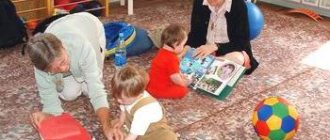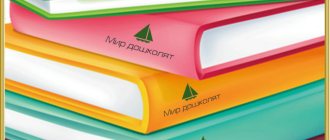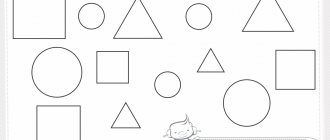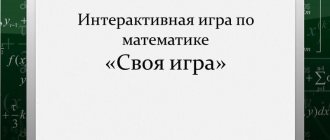The role of didactic games in FEMP classes in kindergarten
The age of 5-6 years is the most important time in a child’s life. At this time, fantasy and logic are formed, the arbitrariness of mental processes and self-esteem are formed. Children always want to know - why, how, why?
Lesson with numbers
At the preschool educational institution, the preparatory process for an educational institution begins, and cognitive activity develops. This is precisely the goal pursued by FEMP pedagogy. Children must not only be able to count to 10 back and forth, but also analyze information data, conduct analysis, classify different phenomena, find common patterns, be smart, and be able to explain and prove a personal point of view.
Didactic games on FEMP in the preparatory group
Types of Math Activities for Kindergarteners
Didactic mathematical games are divided into certain groups according to their content. Type of DI:
- with figures and numbers;
- time travel;
- orientation in space;
- with geometric shapes;
- to logic.
Thanks to different types of games, students are taught to count forward and backward, and to use actions according to the rules of numerals, both quantitative and ordinal.
Didactic games in mathematics
Training sessions involve the use of various pedagogical techniques:
- visibility;
- gaming technologies;
- verbal conversations;
- outdoor activities;
- frontal surveys.
A special place in the educational process belongs to the development of the student.
Game with geometric shapes
Any summary of FEMP in the middle group of the second year of study involves the use of visual materials:
- benefits;
- standards;
- pictures;
- photo.
For your information. This allows students to fully perceive objects, their qualities and characteristics.
Examples of homemade didactic games for FEMP
Mathematics and algebra by definition are plus and minus, triangular and square shapes, different quantities, greater than and less than signs. There is no need to invent a bicycle. Mathematical thinking is formed from the first year of life. A child from his crib observes a rectangular window, a round light bulb, a square sheet or a triangular scarf.
For your information. Everything that surrounds has the form of geometry. Therefore, independent activities with colored geometric figures will captivate the kindergartener 100%.
You can make the figures yourself from wood or cardboard. It is important that there are many of them and they are of different colors. Having the material, you can play and develop the child, select by colors, shapes, quantities, and so on.
Card index of games according to the Federal State Educational Standard
The card index is represented by different games. For example, it is worth considering the DI “Animal Conversation”. Its goal is to expand the child’s vocabulary and develop articulation.
In order to start playing, you need to take a ball. The students stand in a line, and the teacher opposite them explains the rules of the game and makes a presentation: he will name the animals and throw the ball to the first participant. The kid must catch the ball, say what sounds this animal makes, and return the ball to the teacher. Then the ball is thrown to the next participant. The game ends when the last ball in the line is received and the task is completed.
Project on artistic and aesthetic development according to the Federal State Educational Standard at a preschool educational institution
For your information. You can play differently: the teacher pronounces sounds, and the children must guess the animal that pronounces them.
Card file of didactic games and game exercises for FEMP card file in mathematics (senior group)
"Fishermen and Fishes"Goal: Improving the ability to count within 10. Material: cards - fish; cardboard buckets.
Progress of the game: The teacher invites the children to be fishermen and put their catch into buckets. Children choose a fish card and place it in the correct buckets. The teacher checks the correctness of execution. You can choose a captain who will check all the fish in the bucket.
“Count the same amount”, “Listen and count”
Goal: Improving the ability to count within 10;
Material: musical instruments, various toys.
Progress of the game: The teacher asks the child to count out as many toys as the number of drum beats he hears. The rest of the children check whether the task is completed correctly. “How many toys are there on the table? Why did you count out so many toys?” asks the teacher. The task is repeated 2 times using different musical instruments. Then the teacher asks the child to count as many toys as there are buttons on the card (the card with buttons sewn on is in the case). The teacher clarifies the rules for counting objects by touch. After completing the task, he asks the children questions: “How many toys did you count? How to check whether the task is completed correctly? (The child takes the card out of the case, and the children match the number of buttons on the card with the number of toys).
"Count how much"
Goal: to practice counting by ear.
Improving the ability to count within 10.
Material: hammer. Progress of the game: The teacher invites the children to count sounds by ear. Reminds you that you need to do this without missing a single sound or getting ahead of yourself. “Listen carefully to how many times the hammer hits.” Extract (2-10) sounds. In total they give 2-3 tasks. Next, the teacher explains the new task: “Now we will count the sounds with our eyes closed.”
"Find a Pair"
Goal: improving the ability to count within 10;
Learn to relate number to number;
Material: cards with different numbers of objects, with numbers, number cards.
Progress of the game: The teacher gives the children cards with numbers and offers to match them with number cards and subject cards.
“Do the same amount” (counting movements)
Goal: improve the ability to count within 10.
Material: cards with different numbers of objects.
Progress of the game: The teacher lines up the children in two lines opposite each other and explains the task: “You will perform as many movements as there are objects drawn on the card that I will show you. You have to count silently. First, the children standing in this line will perform the movements, and the children standing exactly opposite, in this line (indicates), will check them, and then, on the contrary, you will perform the movements, and you will check them.” (The teacher invites the children to name who is standing opposite who and who will check who) Each line is given two tasks. Children are asked to perform simple movements, for example, raise their arms up to their sides, bend over, squat, etc.
"We settled in the house"
Goal: Improving the ability to count within 10.
Materials: cards - number houses, object pictures (tenants).
Progress of the game: The teacher shows the number houses and residents (subject pictures) explains what needs to be done to move residents into the number houses. The number on the roof of the house will show you how many tenants you can accommodate. After completion, the children take turns counting their residents.
Strengthening ordinal counting skills:
“Which one?”
Goal: Strengthening ordinal counting skills.
Material: Fan consisting of 9 petals of different colors.
Progress of the game: The teacher shows the children a fan consisting of 9 multi-colored petals and offers to count them. Then he draws attention to the fact that the petals are different colors, and gives the task to count them in order.
The teacher gives the children the task: “Remember the location of the petals and close your eyes.” At this time he removes one petal. Children open their eyes and determine which petal is missing and where it was located (which is counted).
The game is repeated 2-3 times. Each time the order of the petals is restored.
"Guess what's changed"
Goal: develop memory, attention; consolidation of ordinal counting skills.
Material: several small toys or other objects familiar to children.
How to play: Several small toys or other objects that are familiar to children are placed on the table. The teacher invites the players to remember what is on the table and in what order. Then invite the children to turn away, and at this time the teacher swaps several toys and invites the children to guess what has changed on the table. For each correct answer, the presenter gives a chip. The one who collects the most chips wins.
"Correct the mistake"
Goal: develop memory, attention; consolidation of ordinal counting skills. Material: cards with numbers from 1 to 7 arranged in a chaotic order.
Progress of the game: The teacher looks at the cards together with the children and says, “The numbers forgot their places and got mixed up. Correct the mistakes. Help each number fall into place. Arrange them in order from smallest to largest, i.e. from 1 to 7 (each child individually lays out the number series using paper numbers from 1 to 7).
"Take Your Place"
Goal: Strengthen ordinal counting skills and develop fine motor skills.
Materials: Two sets of cardboard cards with buttons sewn on them in a row - from one to ten.
How to play: Children stand in a row, hands behind their backs, ten chairs in front of them. The teacher distributes cards to everyone. Children count the buttons and remember their number. At the presenter’s signal: “Numbers! Get in order!" Each of the players stands behind a chair, the serial number of which corresponds to the number of buttons on his card. The players show cards and the teacher checks whether they took their places correctly.
Children exchange cards. Game continues.
“Who left and where did they stand?”
Goal: Strengthening ordinal counting skills.
Progress of the game: The teacher calls 10 children, asks them to line up and pay in order. The rest of the children remember what order the guys are in. Then they close their eyes. At this time, one of the children leaves the line. Children open their eyes and determine who left and in which place this child stood.
The game is repeated 2-3 times with a change of players.
Forming an understanding of the relationships between adjacent numbers
(within 10):
“Find one less (more)”
Goal: to develop an understanding of the relationships between adjacent numbers within 10.
Materials: cards with subject pictures.
Progress of the game: The teacher names the number, and the child finds a card with an object picture, which shows one less or one more object.
"Find the neighbors of the number"
Goal: to develop an understanding of the relationships between adjacent numbers within 10.
Materials: cards with numbers.
Progress of the game: The teacher places cards with the numbers 2, 5, 8 and invites the children to identify the neighbors of these numbers, find the corresponding cards and insert them into the empty windows. The teacher finds out: “Which numbers became neighbors of the number two (five, eight) What is the previous (subsequent) number to the number two, five, eight” (Children justify their answer.)
"Find the missing number"
Goal: to develop an understanding of the relationships between adjacent numbers within 10.
Materials: Digital circle.
Progress of the game: Children look at the “Number Circle”, determine the missing numbers and take turns filling in the empty windows with cards with numbers. Then the numbers are called in forward and reverse order.
Consolidating the ability to form numbers from units within 5:
"Make a number"
Goal: to consolidate the ability to form numbers from units within 5.
Materials: circles of different colors.
Progress of the game: The teacher invites the children to “make up” the number 5 (4,3) using circles of different colors. After completing the task, he asks “How many laps have you counted? How many circles of what color did you take? What number did you make up? How did you make the number 5 (4,3) from ones?”
“Pick up as many different objects”
Goal: to consolidate ideas about the quantitative composition of the number 5 from units.
Materials: various objects, toys.
Progress of the game: The teacher shows the number 5 and invites the children to pick up as many different objects and toys. (1 each).
“I know five names...” (ball game)
Goal: to consolidate ideas about the quantitative composition of the number 5 from units.
Materials: ball.
How to play: Children stand in a circle. The teacher explains the rules of the game: “Name three (four, five) names of a girl (boy) and for each name you hit the ball on the floor once. The one whose ball rolled is out of the game.”
Magnitude
Improving the ability to compare up to 10 objects by length (width, height) and arrange them in ascending and descending order
“Correct the mistake” (longer, shorter)
Goal: Improving the ability to compare up to 10 objects in length and arrange them in ascending and descending order.
Materials: Magnetic board, 10 pencils of different colors made of cardboard and different lengths.
How to play: On a magnetic board, pencils of different colors and lengths are placed in a chaotic manner.
The teacher asks the children: “What can you say about the length of the pencils?” Then he suggests arranging the pencils in order, starting with the longest and ending with the shortest.
The teacher clarifies the sequence of actions, asks the children to show the length of each pencil (children use a pointer), remember their location and close their eyes. The teacher swaps 2 pencils (in the future you can change more pencils). Children open their eyes, correct the mistake and justify their actions. The exercise is repeated twice.
"Broken Stairs"
Goal: Improving the ability to compare up to 10 objects by length (width) and arrange them in ascending and descending order.
Materials: 10 rectangles, large size 10x15, smaller size 1xl5. Each subsequent one is 1 cm lower than the previous one; magnetic board .
Progress of the game: A staircase is built on a magnetic board. Then all the children, except one leader, turn away. The teacher takes out one step and moves the rest. Whoever points out where the ladder is “broken” before others becomes the leader. If children make mistakes when playing the game for the first time, then you can use a measure. They measure each step with it and find the broken one. If children cope with the task easily, you can remove two steps at the same time in different places.
"Put it in order"
Goal: Improving the ability to compare up to 10 objects by height and arrange them in ascending and descending order.
Materials: magnetic board, trees of different heights.
Progress of the game: On the magnetic board, trees of different heights are located in a chaotic order; the teacher invites the children to arrange the trees in order: from the highest to the lowest.
Form
Formation of the ability to see the shape of familiar geometric figures in surrounding objects.
"Find a Pair"
Goal: To develop the ability to see the shape of familiar geometric figures in surrounding objects.
Materials: cards with images of geometric shapes divided into two parts; cards with images of objects of different shapes.
Progress of the game: 5 children take part. Each child is offered 5 cards depicting geometric shapes: circle, square, oval, rectangle, triangle. Then, according to the instructions of the teacher, they select cards with images of objects of the desired shape for their geometric samples.
“Find objects of the same shape” (lotto)
Goal: To develop the ability to see the shape of familiar geometric figures in surrounding objects.
Materials: 5 cards with images of geometric shapes in the middle: 1 circle, square, triangle, rectangle, oval. 5 cards each depicting objects of different shapes, for example: round (tennis ball, apple, marble, soccer ball, balloon), square rug, scarf, cube, etc.; oval (melon, plum, leaf, beetle, egg); rectangular (envelope, briefcase, book, domino, picture), etc.
5 children take part. The teacher reviews the material with the children. Children name figures and objects. Then, as directed by the teacher, they match their geometric samples with cards depicting objects of the desired shape. The teacher helps children correctly name the shape of objects (round, oval, square, rectangular).
“Complete the object”
Goal: To develop the ability to see the shape of familiar geometric figures in surrounding objects.
Materials: cards with images of geometric shapes, colored pencils.
Progress of the game: The teacher reviews the material with the children. Children name geometric shapes and supposed objects that are similar to geometric shapes. For example: a circle, what can we draw that looks like a circle? Apple, tomato, ball, etc., children draw objects.
Orientation in space
Exercises in the ability to move in a given direction:
“If you go right, you will find treasure”
Goal: to exercise the ability to move in a given direction.
Materials: paper circles.
Progress of the game: The teacher tells the children: “The wizard hid a treasure and invites you to find it.”
Using a counting rhyme, a leader is selected.
The leader completes the task: takes five steps straight, turns to the right and takes three more steps in pre-arranged circles. The rest of the children follow him. Children find a box and take out stars from it.
"Errand"
Goal: to exercise the ability to move in a given direction; learn to plan your route, develop memory.
Materials: sheet of paper, pencil.
Progress of the game: The child is given instructions: “You need to get to the secret facility (nurse’s office, speech therapist, psychologist, kitchen), remember your path and everything you see along the way, and return back to the headquarters (group).” Returning to the group, the child tells where he walked (ascended or descended the stairs, walked along the corridor), what objects he encountered on his way, what was to his right, to his left. Subsequently, the child, with the help of the teacher, draws the route of his journey.
"Where the toys hid"
Goal: to exercise the ability to move in a given direction; develop memory.
Materials: various toys.
Progress of the game: Children are informed that all the toys are hidden. To find them, you need to carefully listen to the “hints” (instructions) and follow them. After finding the toy, the child tells in which direction he walked, which direction he turned, and where he found the toy.
Improving the ability to navigate on a sheet of paper:
"Remember and Repeat"
Goal: Improving the ability to navigate on a sheet of paper, develop memory.
Materials: cards with images of geometric shapes.
Progress of the game: The teacher shows the children a card with images of geometric shapes, specifies their location and color. Then he offers to remember how the figures are located and asks to repeat them in the same order. The game is repeated 2-3 times.
"What changed?"
Goal: Improve the ability to navigate on a sheet of paper, develop memory.
Materials: geometric shapes.
Progress of the game: In front of the child, geometric figures are laid out on the table in 2 (3) rows, 3 (4) in each row. The teacher invites the child to look and remember the location of geometric shapes. Then the child closes his eyes. The teacher removes some figure and asks to name it and the place where it was located.
Target.Develop logical thinking, consolidate quantitative and ordinal counting within 5. Strengthen knowledge of numbers within 5. Develop the ability to change your role behavior in accordance with the different roles of partners; ability to change playing role. Expand children's knowledge about the work of cafe workers. Foster friendships between children.
Progress of the game
— Children, have you ever been to a cafe? Did you like it there? Let's open a cafe in our group and then play it.
- Guys, let's decide together what we need for our cafe? (tables, chairs, food) Remember, we have already talked about how to arrange furniture in a cafe so that it is comfortable for all visitors. And today we will equip the cafe according to this plan. (The teacher leads the children to the place where the tables are)
- Look at the shape of the lids on our tables? (round, square). Let us arrange them as indicated in our plan.
- Which figure was drawn first? (circle)
— What shape should the top of the first table be? (round)
- Boys, put the table with the round top first.
-What figure is drawn second? (square)
— What shape will the lid of the second table have? (square). Place a table with a square top. What shape will the third table have? (round). Place a third table with a round lid.
- Look, guys, there is no fourth figure on the plan, instead there is a question. Think and tell me what the shape of the fourth table cover should be? (children's answers)
— To make our cafe beautiful, let’s cover each table with a tablecloth. Look, what color tablecloths do we have? (red and yellow). To find out how to do it right
spread out the tablecloths, you and I need to look at this card.
— What color is the first figure on the card? (red). This means that we will cover the first table with a red tablecloth. What color tablecloth will we set the second table with? And the third?
— What color tablecloth do you think the fourth table should be set with? (children's answers)
— Guys, in cafes, waiters deliver orders to visitors, so that it is convenient for them to work, there are numbers on each table. Let's put numbers on our tables too. (Children and their teacher arrange the numbers.)
— We have arranged the tables, think about what else we need to do? (Arrange the chairs)
- Children, here are the chairs, each of them has a number on it. Place chairs at tables.
- Guys, we have arranged the tables and chairs for you. What do we need to open our cafe? (Food). That's right, to cook food we need food. Where do you think we can get them? (in the shop). We will send Anton and Egor for groceries; they will be our drivers. And I will be the seller. Here are cards for you boys, they indicate how much and what products you will have to purchase and bring by car.
- And you girls will be waitresses and set the tables. Place cups and saucers on each table and don't forget to decorate the table with flowers. (The girls set the tables, the boys “purchase” the food.)
- And now I will be the director of the cafe and I want to check whether the drivers brought us all the necessary products (check).
“And now I’ll check the work of our waiters, whether they set the tables correctly.” So, I am satisfied with the work of both the drivers and the waiters. Our cafe is ready to welcome visitors.
- Girls, you can take your girlfriends and daughters and bring them to our cafe.




